Waterloo Regional community takes stock of the LRT


In anticipation for the new light rail transit (LRT) transit system to officially open, KW community members have begun to evaluate the new system.
Throughout the process of installing the new ion train system in the KW community, there have been many critiques from residents of both Kitchener and Waterloo.
The LRT will have 22 stops, along a 36 km corridor between Conestoga Mall in Waterloo and Fairview Park Mall in Kitchener. The train will pass the main shopping districts, reach both malls and pass the Grand River Hospital.
The train will also pass both Wilfrid Laurier University and the University of Waterloo, although some are wondering if the train will be as beneficial for students as it sounds.
“[Considering] students who live on residence east of King Street, that’s a bit far for them to walk and catch the LRT, especially in bad weather,” Robert McLeman, professor for the department of geography and environmental studies at Laurier said.
The closest LRT stop to the Laurier campus is off of Seagram Drive, east of campus and called the Laurier-Waterloo Park station.
“I think it comes down to convenience, in terms of placement and where you live [around campus], if it was on my street I would probably take the LRT,” Matthew Spanton, a second-year environmental studies student said.
Considering the route and other transit options available, the train is perhaps believed to be more beneficial for students taking trips to the Downtown Kitchener area as opposed to everyday outings such as going to the grocery store.
“Yeah [I would use it] but probably not on a weekly basis but roughly once a month, and for sure as opposed to driving,” Jack Giroux, a second-year environmental studies student said.
One of the major critiques of the new system is the cost, particularly in terms of its capital cost which is $818 million according to the Region of Waterloo website. Although, considering the rapid population growth in KW over the past few decades, a need has developed for a high-quality mass transit system.
“Given the options, which would be: expanding the bus service, an LRT, or [an] underground system, [the LRT] was definitely needed and I think the choice of putting it where it is right now made a lot of sense,” McLeman said.
The LRT system also provides a better quality transit experience since riders often prefer the quality of experience on a train rather than a bus.
“It’s necessary in terms of the city; you can’t get much bigger without having an LRT system,” Spanton said.
Community members are also concerned with how the new transit system may influence the current GRT bus service, considering the people who are most dependent on public transit are students, the elderly and retired, those with lower socioeconomic status and those who don’t own a car.
“Its route will get the highest density of riders and probably serve the clientele that most needs it or is more interested in public transit at the beginning,” McLeman said.
There are also implications that the new system may have an impact on the surrounding housing area.
“Generally speaking, what happens when you have access to these systems [is that] the value of those properties tend to go up,” McLeman said.
“We will probably see a redevelopment of commercial and residential properties within walking distance of the LRT, and one of the impacts may be that the affordable housing right now might go up in price.”
Many growing pains are also imposed on the community when installing a major transit system, as there has already been many in terms of the construction of the tracks.
“A lot of the businesses have disappeared along the construction route, just looking at Uptown Waterloo, a lot of the business on King Street have turned over in the last 18 months,” McLeman said.
Another concern of community members is the direction of the LRT line, which essentially runs along the King Street corridor, which is only north and south. The train also stops in Kitchener and does not continue on to Cambridge.
“We will have to seriously consider expanding it to include some east/west feeder lines and extending it down to Cambridge so that it becomes the main component of public transit in the KW region,” McLeman said.
Looking into the future, after the first track is up and running, considering the next expansion of the track that will follow is important.
“A critique might be that you will want to expand the LRT to an east/west, along say Erb Street in Waterloo or Victoria Street in Kitchener so people can be fed onto the main north/south line,” McLeman said.
“This shouldn’t be seen as the final step, we will have to continue a commitment to the LRT street railways.”

